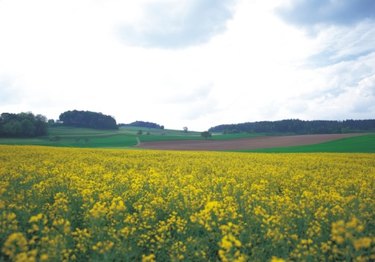Things You'll Need
Spade or shovel
Plastic bucket
Soil test kit
Plastic baggie
Lime
Phosphate
Potash
Tractor with disk harrows
Boron
Water
Irrigation system
Grass suppression herbicides (glyphosate or paraquat)
Seed
Specialized drills, double corrugated roller seeder or seeder
No-till seeder

Alfalfa is found in most parts of the world. It is popular because of its high feed value and productivity. Of all perennial forage legumes, it has the highest success rate and produces the highest yield. The large protein content makes it a great addition to grains and corn when determining livestock rations. Alfalfa can be planted for hay, pasture, soil improvement, silage and soil conservation. Plant alfalfa in an existing field by first preparing the ground and removing weeds.
Step 1
Gather soil to form a sample for testing. Dig 6-inch deep holes at various places in the field to be sown with alfalfa. Combine some of the soil from the bottom of each hole in a plastic bucket. Examine the soil for moisture content. Alfalfa needs deep, well-drained soil. It does not grow well in wet soil. The vigorous root system will grow deep enough to get the water and nutrients it needs. That's why alfalfa can survive through dry periods.
Video of the Day
Step 2
Test the soil. Send a small amount of the combined sample in the plastic bucket to a cooperative extension or university laboratory. The results will tell you which nutrients are needed. If the pH is below 6.2, add hydrated lime to get it into the desired range of 6.5 to 7.0. If the pH is higher than the desired range, add sulfur to lower it. Do this six months in advance so it has time to take effect. Add phosphate and potash, as well, because they are essential for growing alfalfa. The soil test will tell you how much is needed.
Step 3
Loosen up the soil with a tractor. Perform a primary tillage immediately after the removal of the previous plantings, then disk the land. The disk or disk harrows are implements that use steel blades to cut through crop remnants and packed soil. This will remove large clumps, aerate the soil and make it a smooth surface for the alfalfa seeds.
Step 4
Spread boron in the field. Use 1.5 to 2 pounds of elemental boron per acre of land. Dissolve it in water and spray it over the field or apply it straight in the form of borax.
Step 5
Sow 20 to 25 pounds of alfalfa seed per acre in early spring or late summer. Take into account the expected freeze in your region. Spring plantings need to be done once the danger of late freezes is over. Late summer plantings need six to eight weeks to germinate before the first heavy frost.
Step 6
Use a grain drill, a specialized drill, a no-till drill, a minimum-tillage drill, a double-corrugated roller seeder, or a seeder mounted on a flotation-wheeled vehicle to distribute the seed. A specialized drill places the seed at the correct depth of 1/4 inch to 3/4 inch. Packer wheels then firm the soil. Double-corrugated roller seeders drop the seed and firm the ground. A seeder on a flotation-wheeled vehicle works well on flufflier or dry soil by blowing the seed onto the soil and lightly packing it.
Step 7
Use a no-till seeder to spread alfalfa seed on a slope or in shallow soil. A no-till seeder has a narrow slit that drops the seed at a depth of 1/4 to 1/2 inch. Use 1/2 bushel to 1 bushel of seed per acre if you are interseeding the alfalfa with a small grain crop.
Step 8
Give alfalfa 70 to 90 days to grow before the first harvest.
Tip
In dry soil, after preparing the field wait until at least an inch of rain falls to plant the seed.
Use grass suppression herbicides such as glyphosate or paraquat before sod-seeding alfalfa to eliminate weeds and grasses and promote germination. Follow the instructions on the label.
Warning
Do not allow the growth of weeds, such as fall panicum, crabgrass, chickweed or foxtail. They can drastically reduce alfalfa plants.
Video of the Day